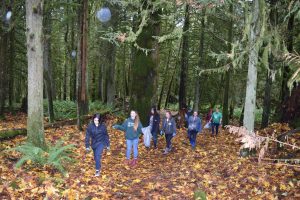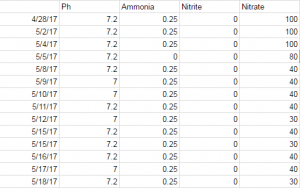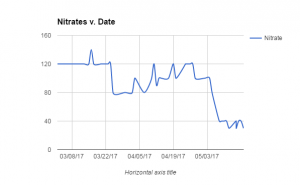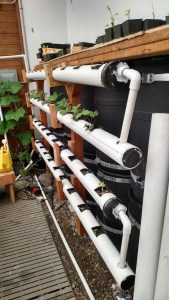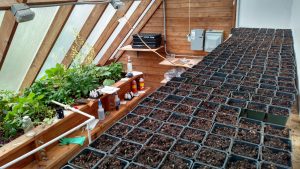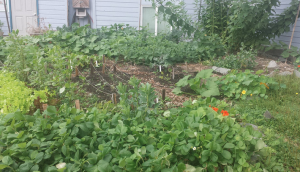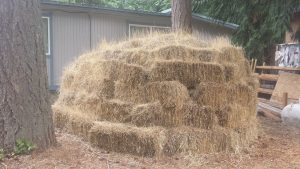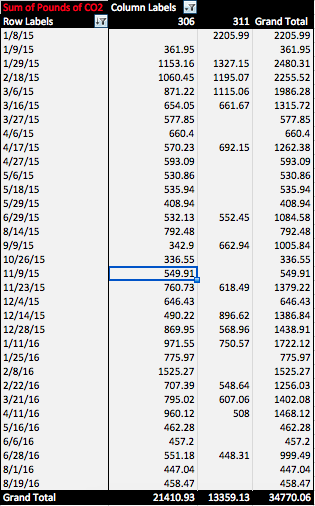RAD Facilities partnered with RES Life last Friday to organize a woods cleanup event through the trails of the North campus woods. You can thank these students, RAs, and student workers for keeping our forest clean!
Interested in solar? We have 18 photovoltaic solar panels on top of MOD 302. This November, they’ve produced enough electricity to completely power the refrigerator every day of the month.
Check out how they are holding up in all of this grey here:
https://enlighten.enphaseenergy.com/pv/public_systems/ggfa523388?preview=1
Here’s a look at some of our water data from the aquaponics fish tank over last few weeks. Since the installation of the horizontal nutrient system, we have noticed a dramatic drop in our Nitrate levels which have dropped to our more sustainable target zone between 20 and 50 ppm. The graph shows how high the Nitrate levels were prior to the horizontal system, which now holds 32 plants which have been using the excess nitrogen (and using it effectively, our strawberry plants are flowering and close to bearing fruit) to spur growth, and how their consumption has caused a major drop to healthy levels.
We have recently put in a horizontal nutrient addition to our aquaponics setup! Water is pumped from our fish tank to the top pipe which then constantly flows through through the underlying pipes and roots of our plants thanks to gravity. We’ve already noticed flowering in a couple of our strawberry plants within a week of adding them to the system. This setup requires even less water than our original (and still existing) media bed system.
The aquaponics greenhouse is flourishing! We currently have 10 full-grown tilapia who are enjoying life in their spacious tank while contributing to the growth of our squash, broccoli, and tomatoes in our aquaponics system. We have also added 13 baby tilapia to our office where we are watching attentively and watching their development excitedly.
Finally, we have planted 111 seeds including basil, cilantro, jalapeno, broccoli, eggplant, yellow tomato, red tomato, cherry tomato, cucumber, red bell pepper, yellow bell pepper, yellow squash, zucchini, pumpkin, muskmelon, and watermelon which are resting on the top shelf soaking up the ample sunlight. Stay tuned as these seedlings may be given away to some lucky Greeners!
Take a look at the greenhouse!
On October 26, RAD Sustainability took a trip to Cedar Creek Corrections Center (CCCC) in Littlerock, WA. CCCC is one of many Department of Corrections locations that participate in the Sustainability in Prisons Project (SPP). In 2003, SPP was a program co-founded by Evergreen faculty member Dr. Nalini Nadkarni. CCCC was the first Washington Department of Corrections facilities to participate in the program.
SPP’s vision is: “This union of ideas and activities – and people inside and outside prison walls – creates a collaborative, intellectually stimulating environment in which incarcerated men and women play key roles in conservation and advancing scientific knowledge. We encourage teamwork, mutual respect and a stewardship ethic among individuals who typically have little or no access to nature or opportunities in science and sustainability. Our vision is not only to save tax dollars and natural resources, but also to help offenders rebuild their lives for the benefit of all.”
RAD Sustainability went to Cedar Creek Corrections Center to pick up tilapia for our aquaponic greenhouse off of N Apartment in Lower Campus. The tilapia are doing well in their new home and you can email radsustainability@evergreen.edu to schedule a tour of the aquaponic greenhouse and see the tilapia.
More information on the Sustainability in Prisons Project can be found at: http://sustainabilityinprisons.org/
Written by Cecelia Verde with research done by Sarah Scott
Next week we are headed over to Cedar Creek Corrections Center to pick up tilapia that they have been growing in their aquaponics system. The prison has a large and successful system that is fully maintained by inmates. We will be fortunate enough to tour the facility, get some tips and see how an efficient aquaponics system operates.
We are particularly excited to be getting tilapia and thoroughly believe they are the right fish for our greenhouse. Tilapias are naturally rugged fish; resistant to disease and parasites, temperature changes, high levels of ammonia and low levels of oxygen.
In an aquaponics system all of these needs should generally be met with little effort. Although fish naturally produce ammonia through their waste, bacteria and the growing plants convert and absorb it respectively. Oxygen is provided during the water’s circulation between the tank and bed. On the off chance that something does come up, tilapia’s strength will give us ample time to address the situation without putting their lives in danger.
We are planning on eating the tilapia! These fish are also super cool because their meat is naturally bland. This gives the caretaker the freedom to adjust the flavor via the fish’s diet and water quality. Giving tilapia a variety of food and potable water adds to their flavor complexity and makes for a tastier fish. We plan on giving the tilapia a high quality food designed especially for them and duck weed. We are adjusting the water quality by making sure what we are adding to the tank is dechlorinated (which involves letting the water sit out for about 12 hours) and something we would all be willing to drink.
In order to eat the tilapia we have to make sure we have enough to keep the system running. This will be done through strategic breeding in separate tanks. Tilapia can spawn every 4-6 weeks and fry, like adults, are relatively easy to care for. The fry will mature quickly and will be ready to eat in only 7 months! Once we have replacement fish we will be able to eat the present adults.
Please feel free to come into the Mod Shop, ask for a tour and meet our new fish!
For more info on tilapia farming check this out:
https://lakewaytilapia.com/How_To_Raise_Tilapia.php
For more info on Cedar Creek Corrections Center:
http://www.doc.wa.gov/corrections/incarceration/prisons/cccc.htm
By Joe Clevenger and Rhianna Hruska, RAD Sustainability.
If you’re a student at The Evergreen State College and have an interest in sustainability, you could possibly start an internship with the sustainability crew at RAD Services. You can gain some college credit and these internships are a great way to get out into the field and do independent work on hands on projects. Some of the fields that we’re exploring are mycology, aquaponics, community gardening, renewable heat and electricity sources e.g. solar and compost heating, data collection, and general sustainability studies.
In the past we’ve had students help us establish and maintain the many gardens on campus, a student focused on solar panels to helped us to analyze data and assess how well our solar panels were producing electricity and heat, and other students helped us to cultivate mushrooms in the sustainability lab in C building. If you would like to do any of these things or you have an idea for a different sort of internship please send us an email at radsustainability@evergreen.edu. In this email let us know who you are, what your sustainability based interests are, and possibly your vision for your internship. We’ll email you back with more information about how to set up an internship and how we think your internship will work. If you email us in fall, you’ll have until the end of week 10 fall quarter to set up an internship for winter quarter and if you email us in winter, you’ll have till week 10 of winter quarter to set up a spring internship. We’re dedicated to working with you to not only further your own sustainability studies, but also to spread the word about sustainability at Evergreen. A key part of sustainability is sharing knowledge, spreading the word about successes and failures, and trying to include many people in the projects that we are working on.
Here is a list of potential projects that students can either volunteer or intern for:
Solar Evergreen: Photovoltaics and Solar Thermal
- Evaluate existing projects at RAD
- What is operating, where?
- How well is it working?
- Does it need repair or maintenance?
- Is it saving or producing energy? How can we tell? How much?
- Can it do better? What would it need?
- Help plan future projects
- Costantino Recreation Center: solar thermal to heat pool and/or showers?
- Recreation Pavilion needs a new roof – can it be solar PV?
- expand the Library Photovoltaic installation
Forest Garden Specialist
- Reinvigorate the forest garden
- assess current situation:
- What is planted?
- How is it doing?
- Do we need more light and where?
- make recommendations:
- new plantings: what sorts of communities can exist?
- how do we create potentials for grazing?
- assess current situation:
- new irrigation system/method
- maintenance system
Mushroom Maintenance
- Assist w developing mushroom path project
- Develop mushroom production on campus
- find indoor space
- must be well ventilated
- choose multiple varieties/methods of growing
- find indoor space
Garden Maintenance
- Weeding
- Soil/Plant health
- Integrated Pest Management (IPM)
- Harvest/Plant
- Water/irrigation
- Research opportunities
- Integrated Pest Management
- Nutrient cycling
- Plant Botany
- Different methods of tilling/planting
Compost Maintenance
- Manage compost heat pile
- Enter and analyse compost heat pile data
Sustainability Photojournalist
- Photographing RAD at work in sustainability
- Photographing other sustainability efforts on campus
- Blog and writing about sustainability
- Submit to the Cooper Point Journal, Green Pages, and other local media
- Could post photographs to the RAD Sustainability Instagram or Twitter
Greenhouse/Aquaponics
- Temp/light intensity data
- Insulative winter nighttime blanket
- Vertical/Horizontal growing
- integrating clams/shrimp
- comparing growth rates in greenhouse to growth rates in adjacent garden
- nutrient cycling
- plant & fish pathology
- botany
- microbial activity
RAD Sustainability Event Coordinator
- Coordinating volunteer days
- Coordinating workshops
- Speakers
10 hours of work/research per week = 4 credits
You can potentially budget 1-2 more shifts than they need each quarter to allow for 1-2 absences throughout the quarter without requiring additional shifts or research.
Credit earning will require faculty coordination
Some folks can do the internships through class just by setting aside hours
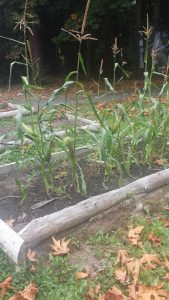 Looking for a place on campus to garden? Look no further than the raised garden beds behind the Housing Community Center!
Looking for a place on campus to garden? Look no further than the raised garden beds behind the Housing Community Center!
These 8 x 4 garden beds are available for residents looking to grow and harvest their own fruits and vegetables throughout the year.
Residents interested in planting in these gardens can email: radsustainability@evergreen.edu. RAD Sustainability can also help to provide seeds or starts for residents interested in gardening.
To meet with the RAD Sustainability crew, stop by the Facilities Shop (Mod 310) at these times Fall Quarter 2016:
Monday, Wednesday, & Thursday 9am-5pm or Tuesday & Friday 1:30-5pm
Compost Heat Recovery System
Published September 26, 2016 2016 , Clean Energy Committee , Compost Heat Recovery , Data 1 CommentBy Joe Clevenger and Rhianna Hruska, RAD Sustainability Team.
If you haven’t been there already, go and check out the back side of mod 311 on the lower part of campus. It’s a beautiful area with wood and metal recycling containers, but more importantly, it’s home to a large pile of straw, wood chips, and horse manure. This pile is called a compost heating pile and is actually used for space heating in mod 311! This mod uses propane as a back up heating method and we’ve been collecting propane consumption data on the mods to get a feel for how much carbon dioxide our compost heating pile could potentially offset.
Abstract:
Our compost heat pile consists of 60% wood chips, 30% saw dust, and 10% horse manure. As you can see in the picture above, these resources are piled into a shell of straw bales. The interior resources break down over the course of a year and produce temperatures up to 250˚. The average recorded temperature for the Mod system is between 120˚ and 130˚ F. This heat is harnessed and transferred into water that’s flowing through the pile in PEX tubing. We then take this water and pump it into an in floor radiant heating system that handles space heating in the mod. As hinted at earlier, this heat production slowly decreases over the course of a year and after a full year the entire pile needs to be replaced.
A compost pile is a great way to generate heat without contributing to carbon dioxide emissions. By using compost or other “cleaner” heating sources you can help to offset carbon dioxide. This offset is basically the difference in carbon dioxide emissions between clean energy sources and dirty energy sources. To subvert some of the environmental damages that we’re causing and to maintain a habitable environment on earth, we need to offset as much carbon dioxide as we can.
Analysis:
As stated earlier, Mod 311 uses propane as a backup heating system. For the past two years, we’ve been closely tracking the propane consumption of all the Mods. This has allowed us to compare Mod 311 to Mod 306, which also has an in floor radiant system, but depends solely on propane for heating. After running the numbers, the data showed us that since January of 2015 Mod 306 used about 600 gallons of extra propane as compared to Mod 311. According to eia.gov, every gallon of propane burned emits 12.7 pounds of carbon dioxide (https://www.eia.gov/environment/emissions/co2_vol_mass.cfm). With that math, that 600 gallons of propane equates to 7,200 pounds of carbon dioxide! Below are some pivot tables generated from our raw data to give you a better understanding of this statistic. The first column represents the date the propane tanks were filled, the second columns show how much propane was added to 306 and 311 respectively in gallons, and the last column is the total of both. The propane tanks we have are filled as needed to a standard limit, so when ferrell gas, the company that supplies the propane, comes out the amount they add to the tank is the amount burned from the last fill date to now.
If you want access to our full data set feel free to send an email to radsustainability@evergreen.edu.
Significance:
The obvious significance of this project is the ability to use compost heating to reduce our dependency on fossil fuels. Our climate is becoming more and more unstable as we emit greenhouse gases into our atmosphere. If we can move away from fossil fuels and use more alternative energy sources we can potentially avoid massive storm caused catastrophes, stop different cultures and resources from being eradicated by a rising sea level, as well as avoid conflicts that may arise from depleting global resources.
Another significance of this project is the fact that Gaelan Brown, the VP of marketing at Agrilabs, helped student employees at The Evergreen State College learn about and implement the compost heating pile we now have on campus. Just as we are sharing this information with you now, Agrilabs shared their information with RAD Services and has helped to offset at least a small amount of carbon dioxide. The bigger picture here is that our project and knowledge could be a precursor for other projects like it and we’re planning to collect more data on the compost heating pile to assess the scalability of it.
Our next steps are to install temperature monitors for ingoing and outgoing water for the compost in floor radiant heating system as well as a flow meter for the system. This will allow us to accurately calculate the amount of British Thermal Units (BTUs) the compost pile is producing and to hopefully share that data with students wirelessly.
